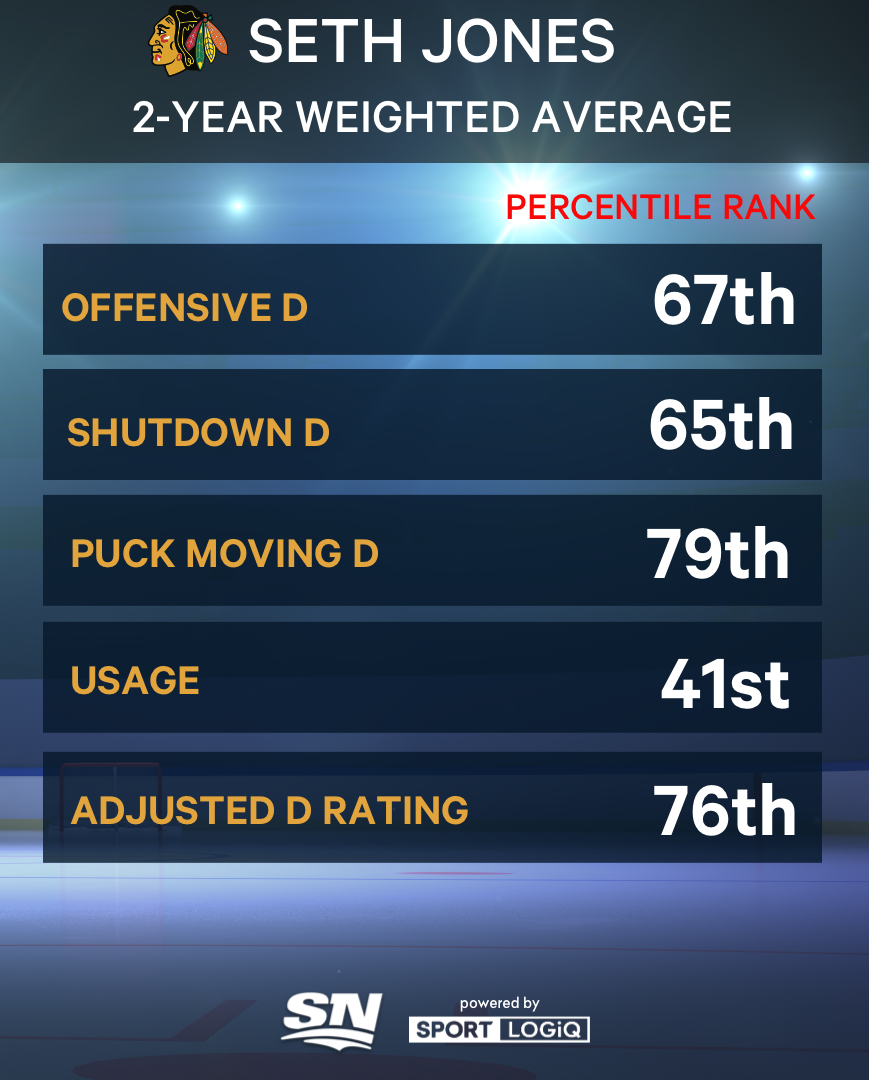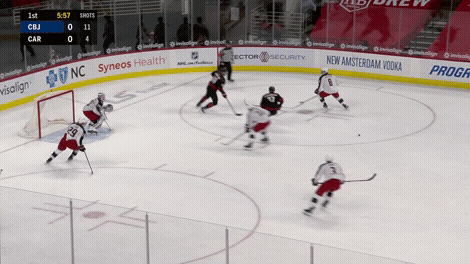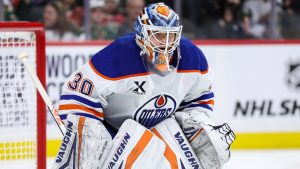Seth Jones is now a member of the Chicago Blackhawks.
By now, you’ve seen the details of the trade and the massive contract Jones is expected to sign next week — eight years, $9.5 million per season. That would make Jones the third highest-paid defenceman in the National Hockey League behind Erik Karlsson and Drew Doughty. Jones is not the third-best defenceman in the NHL, but that’s not how this works. Karlsson and Doughty aren’t top three either.
There will be no shortage of debate as to whether the Hawks gave up too much to get Jones or whether he’s worth the massive amount of money Chicago is set to pay him, but for the purposes of this article, let’s simply evaluate Jones as a player. He’s one of the most polarizing in the league, exceptionally talented yet flawed at the same time. Labelled as elite by some and straight up bad by others. My take, far from a hot one, is that he falls somewhere in between.
You might have read that analytics paint a pretty bleak picture of Jones. Well, the funny thing about analytics is a certain degree of interpretation is required. Analytics never say one thing or another about a player. Data is collected, modelled, interpreted, and presented. Just like scouts who watch video, analysts whose primary source of analysis comes by way of studying data might have different opinions on a player based on the information they use and how they interpret it.
I do not believe Jones is an elite defenceman, as some who use traditional evaluation methods believe. I do not believe Jones is a below-average defenceman, as some whose analysis is data-driven believe. My view of Jones is he’s a top-pairing defenceman who comfortably ranks well above average in several key performance areas.
Using Sportlogiq’s player archetype model, here is a look at Jones’ percentile ranks in key performance areas using a two-year weighted average.

These are not the type of numbers that warrant a long-term contract at $9.5 million a year. They aren’t numbers that scream below average either. Let’s break it down in more digestible terms.
OFFENCE
Jones has seen his points per game total drop over the past couple of seasons to 0.52 from 0.64 in the three seasons prior. Despite a down year this past season, Jones still ranked 26th in scoring chances among qualified defencemen at even-strength, per 60 minutes. Jones is still an elite skater (we’ll get to that in a minute) who ranked 17th in rush scoring chances and 37th in expected goals. Again, not cream of the crop numbers, but still impressive in a season that was likely an outlier on a Blue Jackets team that struggled to generate offence.
The Blackhawks are a high-event team that likes to trade chances in transition and Jones will likely benefit offensively by playing a system that is quite different from the traditionally defence-first approach in Columbus. The Hawks ranked top-five in rush chances and goals last season. If Jones is given free rein to jump into the play, Hawks fans should expect a spike in his offensive numbers.
DEFENCE
A total of 174 defencemen played at least 500 minutes at even-strength last season. Seventeen had a worse expected goals against rate than Jones who was on the ice for 2.85 expected goals against per 60 minutes. Jones’ expected goals for percentage of 44.6 per cent ranked 144th. Not exactly encouraging. To make matters worse, only four teams had a worse expected goals against rate than the Blue Jackets last season and Chicago was one of them. Jones’ new team was worse defensively than his old team so there won’t be anywhere for him to hide in Chicago.
That said, quantifying defensive impact isn’t as simple as evaluating ‘while-on-ice’ numbers, even isolated impact. The reality is, there are far too many variables that can not currently be accounted for to say with 100 per cent certainty how good or bad a player is defensively. Know what you don’t know — and there is still plenty we don’t know about assigning value for defensive impact in hockey. Is it possible to be more right than wrong? Absolutely.
What we do know is the Blue Jackets gave up far more than they created in terms of scoring chances with Jones on the ice last season. The same can be said of all of Columbus’ top-four defencemen. Columbus was a bottom-five team. Rod Langway in his prime would have had a tough time posting a positive expected goal share.
Jones is not an elite, shutdown defender by any means but he isn’t a massive liability either. Last season, Jones ranked 29th in blocked passes per 60 minutes at even-strength. No, this does not mean his overall defensive game is great, but it is tangible evidence of a player positively impacting the game away from the puck. Adam Pelech, MacKenzie Weegar, and Jaccob Slavin — all excellent defensive defencemen — ranked top-three in this metric.
Jones is also not a liability in his end in terms of turning the puck over. At even-strength, Jones turned the puck over on 11.4 per cent of his defensive zone possession, 32nd among qualified defencemen. Where Jones struggled was defending entries and limiting cycle chances against. My suspicion from watching him play is that Jones often runs himself out of position in the defensive zone, which gets him into trouble.
My assessment of Jones as a defensive defenceman leans more towards average than well above or below. As mentioned, there won’t be anywhere to hide on a Blackhawks team that was one of the worst defensive units in the league last season so don’t expect Jones’ expected goal differential to be much better next season.
PUCK MOVING
Jones ranked 30th in controlled zone exits per 60 minutes at even-strength last season, sandwiched between Jakob Chychrun and Victor Hedman. In controlled zone entries, Jones ranked 18th among qualified defencemen. The transition game is still an area where Jones excels and this will be a welcome addition on a Chicago team that loves to move the puck quickly out of the defensive zone.

The Blackhawks are not a dump-and-chase team and Jones will be given every opportunity to skate the puck with his new club.
Jones is going from a Blue Jackets team that played a fairly low-event style of hockey for the majority of his tenure in Columbus, to a Blackhawks team that is the exact opposite. Chicago creates a ton of chances and allows just as much against. Whether Jones’ on-ice impacts improve on a very different style of team remains to be seen but, like in Columbus, he will be asked to eat big minutes in all situations as his team’s top defenceman.
Jones is not a replacement level defenceman, far from it, but it’s tough to imagine him contending for a Norris Trophy in Chicago. Fair or not, players are often measured against their cap hit and it’s not likely the 26-year-old, who will be 28 when his extension kicks in, will live up to the mammoth contract the Blackhawks are about to sign him to.
[relatedlinks]




